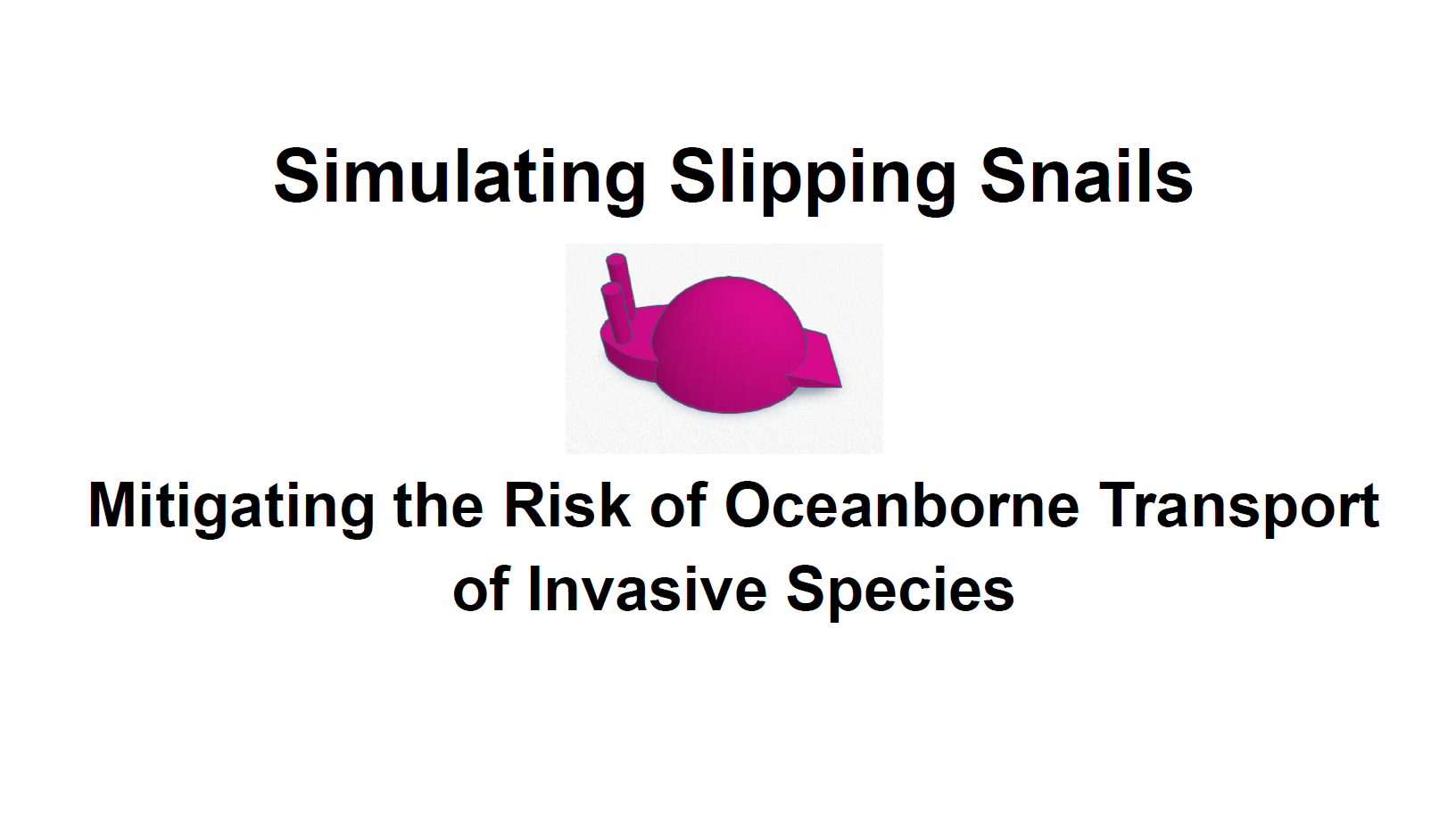Simulating Slipping Snails: Mitigating the Risk of Oceanborne Transport of Invasive Species
Abstract:
Invasive species have devastating effects on ecosystems, and cost the US economy over $120 billion per year. About 42 percent of threatened or endangered species are harmed by invasives. The zebra mussel alone is estimated to cause up to $650 million per year in economic damage to the Great Lakes region, and spread disease to native waterfowl. With increased global transportation and commerce comes the threat of taxa being introduced to
ecosystems where they spread aggressively and cause harm. Watercraft from recreational boats to ocean going cargo ships rely on hull coatings to prevent biofouling, or the growth of aquatic organisms on their hulls, to maximize speed and minimize fuel consumption. With a global cargo ship fleet consisting of over 50,000 vessels, effective coatings not only detertransfer of species between ecosystems, but also affect billions of dollars of fuel consumption. There is a devastating human, financial, and environmental cost of invasive species. This project explores the principles of aquatic invasive species transport, from hull adhesion to ballast water contamination. Variation in surface chemistry and geometry were compared. DNA Barcoding was used to positively identify an invasive invertebrate. A statistical analysis of the data shows how ship hull surface chemistry and geometry can help to mitigate the risk of inadvertent invasive species transport.
Bibliography/Citations:
No additional citationsAdditional Project Information
Research Plan:
Invasive species have devastating effects on ecosystems and cost the US economy over $120 billion per year. About 42 percent of threatened or endangered species are harmed by invasives. The zebra mussel alone is estimated to cause up to $650 million per year in economic damage to the Great Lakes region and spread disease to native waterfowl. With increased global transportation and commerce comes the threat of taxa being introduced to
ecosystems where they spread aggressively and cause harm. Watercraft from recreational boats to ocean going cargo ships rely on hull coatings to prevent biofouling, or the growth of aquatic organisms on their hulls, in order to maximize speed and minimize fuel consumption. With a global cargo ship fleet consisting of over 50,000 vessels, effective coatings not only deter transfer of species between ecosystems, but also affect billions of dollars of fuel consumption.
This project will explore various surfaces and coatings, testing for ability to deter adhesion by aquatic invertebrates, and also for reduction in hydrodynamic friction. Additionally, ballast tanks will be evaluated for a more environmental solution.
Research Questions:
1) How does surface chemistry affect biological adhesion?
2) How does surface geometry affect biological adhesion?
3) How do surface coatings affect hydrodynamic friction?
4) How does surface geometry affect hydrodynamic friction?
Procedures:
1) A statistical sampling plan will be designed to represent variation in surface chemistry
and surface geometry.
2) A test model of a cargo ship hull surface will be constructed.
3) An electric pump motor will be installed and wired with a safety disconnect and Ground
Fault Current Interrupt (GFCI).
4) Biological adhesion will be measured.
5) Hydrodynamic friction will be measured
6) DNA Barcoding will be used to positively identify taxa.
7) Simulation software such as Computational Fluid Dynamics analysis will be used to
analyze adhesion of an invasive species model organism to a substrate.
Risk and Safety:
Personal protective equipment will be used. Safety disconnect and Ground Fault Current
Interrupt will be installed.
Data Analysis:
1) Results will be analyzed using spreadsheet software
2) Results will be analyzed for statistical significance
BIBLIOGRAPHY
“Bang Goes the Theory, How Do Snails Stick to Things?” BBC One , BBC,
www.bbc.co.uk/programmes/p004bytk.
Chan, Brian, et al. “Mechanical Devices for Snail-like Locomotion.” Journal of Intelligent
Material Systems and Structures , vol. 18, no. 2, 2006, pp. 111–116.,
doi:10.1177/1045389x06063464.
Chapman, Charles F., and Elbert S. Maloney. Chapman Piloting & Seamanship. Hearst
Books, 2013.
Estimated Potential Economic Impact of Dreissena Mussel ...
www.aquaticnuisance.org/wordpress/wp-content/uploads/2009/01/Estimated-Economic-I
mpact-of-Mussel-Introduction-to-Idaho-Final.pdf.
“Invasive Species.” National Wildlife Federation ,
www.nwf.org/Educational-Resources/Wildlife-Guide/Threats-to-Wildlife/Invasive-Species.
Kavin, Kim. “This Antifouling Coating Creates a 'Liquid Surface'.” Soundings Online , 24 Jan. 2018
www.soundingsonline.com/boat-shop/this-antifouling-coating-creates-a-liquid-surface.
Kraska, James & Rittschof, Daniel. (2015). Toward a Global Regime of Vessel Anti-Fouling. 26.
“Marine Coating Technologies.” ShipInsight , shipinsight.com/articles/marine-coating-technologies.
Melander, Christian, et al. “Evaluation of Dihydrooroidin as an Antifouling Additive in Marine
Paint.” International Biodeterioration & Biodegradation , vol. 63, no. 4, 2009, pp. 529–532.,
doi:10.1016/j.ibiod.2008.08.009.
“New Order Doubles Selektope Use in 2019.” ShipInsight, shipinsight.com/articles/new-order-doubles-selektope-use-in-2019.
Parker, G. H. “The Mechanism of Locomotion in Gastropods.” Journal of Morphology , vol. 22, no. 1, 1911, pp. 155–170., doi:10.1002/jmor.1050220107.
Ravindran, Sandeep, and Sandeep Ravindran. “Do Snails Need Their Slime Trails to Move Ahead? It's a Sticky Question, Stanford Researchers Say.” Stanford University , 6 Apr. 2011, news.stanford.edu/news/2011/april/snail-slime-trails-040611.html.
“Shipping and World Trade.” ICS, www.ics-shipping.org/shipping-facts/shipping-and-world-trade.
Sánchez, A., and D.m. Yebra. “Ageing Tests and Long-Term Performance of Marine Antifouling Coatings.” Advances in Marine Antifouling Coatings and Technologies, 2009, pp. 393–421., doi:10.1533/9781845696313.2.393.
“Talga Graphene Coating Begins Commercial-Scale Trial on Cargo Vessel.” Coatings World, www.coatingsworld.com/contents/view_breaking-news/2019-11-07/talga-graphene-coating-begins-commercial-scale-trial-on-cargo-vessel/.

